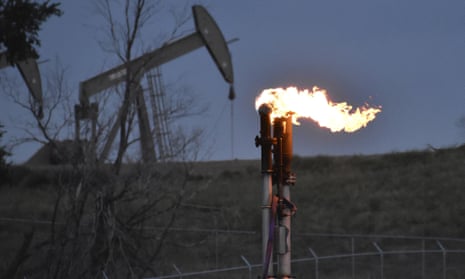Fossil fuel companies must pay tens of billions to reduce the emissions of methane from their operations or it will be almost impossible to meet global climate targets, the world’s energy watchdog has warned.
The US is now the biggest source of methane emissions from oil and gas extraction, as a result of the massive expansion of its oil and gas sector, while China is the biggest emitter of methane from coal mining. Russia also continues to be a major emitter as its fossil fuel operations are poorly run.
Leaks from coalmines and oil and gas wells are the biggest sources of methane, a potent greenhouse gas that has caused about 30% of the temperature increases seen to date, according to data published on Wednesday by the International Energy Agency (IEA).
About 170bn cubic metres of methane was emitted from fossil fuel operations around the world last year, which is more than the entire natural gas production of Qatar.
Yet many of these leaks could easily be plugged if the best practices developed in some countries – such as Norway, which has low methane leaks from its oil and gas drilling operations – were adopted around the world.
Currently, the least efficient operations are about 100 times worse than the most efficient, with Turkmenistan and Venezuela the worst offenders. One well blowout in Kazakhstan last year produced large quantities of methane for more than 200 days.
The IEA calculated, in a global survey of methane published on Wednesday, that $170bn would be needed to reduce global methane emissions by 75%, of which $100bn was needed in oil and gas and $70bn in the coal industry. That would give the world a much-improved chance of limiting temperature rises to 1.5C above preindustrial levels, the report found.
The spending required from fossil fuel companies to clean up their operations would be the equivalent of about 5% of the enormous profits they made last year, the IEA estimated.
Paul Bledsoe, a former Clinton White House climate adviser now with American University in Washington, said the US must ensure all producers followed best practice.
“Now that the US is the world’s largest producer of oil and gas, its industry must finally commit to near-zero methane emissions by the end of this decade, even as the Biden administration regulates methane more strictly, or face a consumer backlash,” he warned. “At the same time, Russia continues to have the highest rate of methane leakage, another reason for the EU and others to continue boycotting the gas that is funding Vladimir Putin’s war in Ukraine. And China must shut down many of its coalmines, as methane adds to CO2 to produce the most greenhouse gas-heavy fossil fuel in the world.”
Despite a pledge of action on methane from more than 200 countries, emissions of the gas remained near to the record high set in 2019, according to the IEA report. The energy adviser’s Global Methane Tracker also found that real world emissions were far higher than countries or companies were reporting.
There were reasons to be optimistic, however, the authors of the IEA report said. Better monitoring of methane emissions is now possible, from satellites, and is set to improve further with the launch of a dedicated methane satellite system from the US NGO Environmental Defense Fund.
“Sometimes it can be quite quick and easy to stop [leaks once identified],” said Christophe McGlade, head of the energy supply unit at the IEA. “We hope the UN can pick this [satellite data] up and use it.”
Tim Gould, co-author of the IEA report, said the forthcoming Cop29 UN climate summit, scheduled to take place in Azerbaijan this November, could provide an opportunity for governments and companies to take stronger action. “Cop29 will take place in a large oil and gas producer – that will help to keep the focus on methane,” he said. “We would also like to see a focus on methane in countries’ NDCS [their nationally determined contributions, or plans under the Paris agreement to cut emissions].”
Durwood Zaelke, president of the Institute for Governance and Sustainable Development, called on governments to heed the IEA’s advice. “Cutting methane is the only way to slow near-term warming and avoid the tipping points that send us into irreversible and catastrophic climate chaos. It’s the blowtorch that’s setting the climate on the boil. Turn it off and the temperature goes down faster than anything we can do,” he said.
